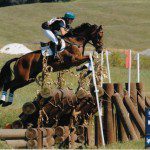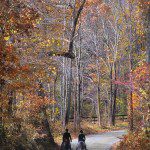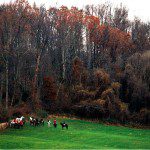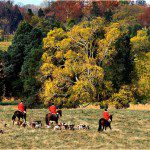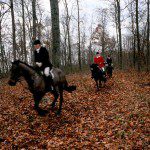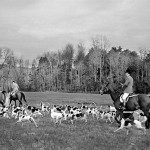On a cool fall morning last year, my daughter was out for a routine hack on her event horse when they had a fall. Taking a chicken-coop about half the size she usually jumps in competition, her horse stumbled on a loose rock and brushed the top of the jump with his knee. He fell and she came off with half of the reins in her hand. The horse got up first and ran frightened, bucking with the remaining reins flapping around his knees. After a short distance, he realized my daughter was no longer with him and stopped. As she sat on the ground watching, he calmly returned, putting his head down to make sure she was okay. What is this bond?
We live on a gravel road that curves along a ridge between two rivers northwest of Charlottesville. The northern river comes out of the mountains nearby and is cold, stony and shallow. The southern river is formed over a long stretch of the county and fed by springs and streams until it reaches my farm where it is slow and sandy. For almost two centuries the shallow and rocky soil of this area was home to farmers, moonshiners and loners. The 1970s gas crisis eroded their already narrow profit margins and the farmers welcomed and sold first to the hippies and then those who could pay real money.
Even with rocky soil, care of the pastures on these hills made sure they were robust. The horses that had done the plowing were replaced by the horses of pleasure, foxhunting and sport. In many ways the area looks the same as it did in the 1950s when my wife rode her ponies through the countryside to the country club to get a hot dog.
My family has a long history with horses including my father, who grew up foxhunting in Orange. When he returned from WWII he kept his hunting mare, Vixen, in the paddock behind my grandparent’s house on Main Street. He rode with Mr. Carter’s Hounds, a private pack in the Rapidan area. Mr. Carter would call to say he was going out and my father would abandon his real estate duties (oh, the days!) and ride down Main Street to join the pack and hunt all day. He admired how little the countryside around my house had changed and I like to think it reminded him of those days with the Carter hounds.
By the time my wife and I met, she had spent a decade in Europe trading the forward seat of her pony days for the more secure, deep-seated riding of the classicists. With this background, we bought our 3-year-old daughter her first pony. Within months, lead shank in hand, I walked alongside as our daughter rode her pony over the rivers and up and down the hills around our home. My wife rode her old horse, and the three of us would be gone for hours. The stories we share are too numerous for this article, but thus began my daughter’s special gift of communication with horses. These little jaunts grew into long truck rides up and down the East Coast, and I have listened as she shared her observations.
Horses are animals of prey and abrupt sounds and unexpected disturbances below their belly still frighten them. With the evolution of the horse from a dog-like size to something that resembles modern structure, the advantages of domestication became readily apparent to our human ancestors. Thus began a successful partnership that changed the history of man in ways more dramatic than the industrial revolution. War, work, trade, sport and even spirituality were changed forever. Think mounted, armor-clad knights facing foot soldiers, the travel of silk and spices to new markets, the emotions stirred by Secretariat (younger readers, check out YouTube) and witness the reverence of cave drawings for freedom and power represented by the horse.
But just like people, horses are different, not just in their size, color or the cadence of their canter but in how they learn and how they return communication. As my daughter moved from ponies to horses, a neighbor and old Swiss cavalry officer insisted she ride many horses to understand these differences. To ride many is the holy grail of an education in horses. With deep-seated technique and balance developed over years of riding cross-country, the use of reins is diminished dramatically to be replaced by subtle movement of the legs and core complemented by verbal command. The untrained horse genetically knows its ancient proud heritage and responds positively to the respect of this effort.
Being an animal of prey, the horse seeks the protection of command and answers the love of human care with incredible devotion demonstrated by my daughter’s horse on that fall day in the woods. He returned to make sure she was all right. Together, they walked quietly home over the rivers and up and down the hills.
Joe Samuels is the broker/owner of Jos. T. Samuels, Inc., Realtors in Charlottesville, Va. He is an equestrian only through the pocketbook. He is a lousy groom but a pretty good truck & trailer driver. As an amateur historian, he has contributed to local publications. His essay on Fiske Kimball and “Shack Mountain” can be found on his website and in the library at Monticello. His daughter, Kate, rides at the advanced level in the sport of three-day eventing.
- Joe Samuels | Courtesy of Joe Samuels
- Jordan Wright
- Nora Birch



